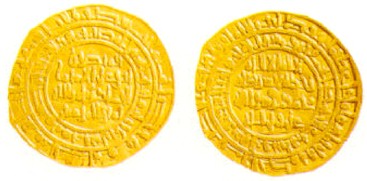During the Fatimid Dynasty, Islamic coins were of such high quality and so abundant that they became the most wide-spread trade coins of the Mediterranean world.
 Figure 1. Early Fatimid coins, Al-Mahdiya, 949.
Figure 1. Early Fatimid coins, Al-Mahdiya, 949.
Extracted from a full article:
Islamic Coins during the Umayyad, Abbasid, Andalusian and Fatimid Dynasties by Wijdan Ali
The first three caliphs, who ruled from their respective capitals, Quayrawan, al-Mahdiya, and Sabra-Mansuriya, issued gold and silver coins that carried purely orthodox Sunni’ legends. The early dinars of al-Mahdi followed the Aghlabid model in size and design, and only the mint name of Quayrawan was added to it.
After 912, slightly larger dinars with a distinctive Kufic script were introduced. In 922, the mint was moved to al-Mahdiya and later to al-Mansuriya. Other mintless dinars were struck either in Sijilmasa, Fez, or a transient army base.
The name of the mint and the date were omitted from quarter-dinar denominations. In 934, al-Qa’im was the first caliph to totally change the design and adopt a handsome monumental Kufic script (figure 9). Quarter-dinars were also struck in Sicily, probably in Palermo, and carried the mint name ‘Siqilliya’ Early Fatimid coins (909-53) are much rarer than those from later periods.
In contrast to coins of the first three Fatimid caliphs, the later ones emphasized their Shi’i identity by declaring their bond to Ali. In 953, Caliph al-Mu’izz issued dinars with a clear Shi’i message and a new design: a short, one-line legend was ringed by three concentric circular legends reading from the inner to the outer bands. The wording, which read “And Ali ibn Abi Talib is the Nominee of the Prophet and the Most Excellent Representative and the Husband of the Radiant Chaste One [i.e., Fatima, daughter of the Prophet],” expressed the essence of the Isma’ili doctrines; but as it offended the Sunni population it had to be abandoned (figure 10). The second and more lasting type of coin omitted the field inscriptions entirely and moderated the strength of the Isma’li idioms. The coins issued under later caliphs varied between three and two circular legends and single and double marginal lines. Between 1014 and 1020, the caliph’s heir apparent’s name was added to the dinar.
After al-Mu’izz, Caliph al-Mustansir was the first to change the design of his coins. His dinars were similar to al-Zahir’s, but with the unit and date formula put in the reverse margin. Between 1048 and 1077, he adopted the three-circle type first used by al-Mu’izz. They are such close copies that it is difficult to tell one from the other. After 1078 the standard of die-sinking became of poorer quality and remained so until 1094.
During the third period of the Fatimid dynasty (1094-1171) an experimental dinar was minted that kept the design of al- Mustansir’s last coins. Although their marginal legends were still in Kufic, the field legends were in a flowing Naskhi script. This was the first time in Egypt that a long Naskhi script appeared on a coin, and it did not reappear until 1227. In 1096 al-Musta’li (1094-1101) introduced a style that remained in use for the next 120 years: a handsome adaptation of al-‘Aziz’s two-circle type with brief inscriptions in the small field in the centre of the die. On the obverse the words “ali ghaya” were placed to indicate the coin’s ‘extremely high’ quality.

Figure 2. Fatimid coin with Isma’ili Doctrine, Egypt, AH386/AD 996.
On the reverse was the caliph’s title and given name along with his other titles of honour. Toward the end of the Fatimid period, when child caliphs succeeded one another and the viziers took over the actual power, coins were struck in 1130 and 1132 in the name of a nonexistent Fatimid prince. In 1133, a coin was struck in the name of the long-awaited imam, al-Mahdi, who according to Shi’i belief should appear at an undisclosed date in the future.
Fatimid coins were of such high quality and so abundant that they became the most wide-spread trade coins of the Mediterranean world. When the Crusaders captured Palestine, they copied the contemporary Fatimid coins instead of striking their own. The Crusader coins ranged from excellent imitations of the original to crudely engraved and sloppily struck pieces that shared only their overall design with their Islamic prototypes.

